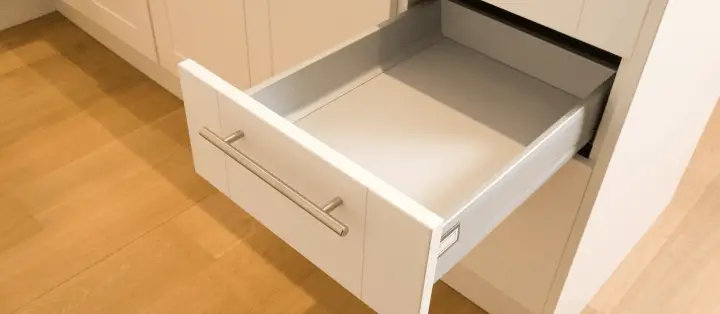
In the realm of furniture and cabinetry, the unassuming yet integral drawer slides play a pivotal role in the functionality, durability, and overall aesthetic appeal of drawers. This comprehensive exploration aims to unravel the intricacies surrounding drawer slides, providing a holistic understanding of their types, mechanisms, applications, and factors influencing their selection.
The Basics of Drawer Slides: Foundations of Functionality
Understanding the basics of drawer slides is fundamental to appreciating their role in the world of furniture design. At their core, drawer slides are mechanical components that facilitate the smooth opening and closing of drawers. The interaction between the slide, mounted on the drawer, and the corresponding track affixed to the furniture frame dictates the ease and functionality of drawer movement.
Distinguishing Between Side-Mount, Undermount, and Center-Mount Slides
Drawer slides come in various mounting styles, each catering to specific furniture designs and functional requirements. Side-mount slides, affixed on the sides of drawers and frames, represent a traditional and versatile choice. On the other hand, undermount slides provide a sleek and modern aesthetic by being hidden beneath the drawer. Center-mount slides, installed at the center of the drawer bottom, find their place in lightweight applications and vintage furniture designs.
Steel, Aluminum, and Plastic: Choosing the Right Material
The material composition of drawer slides is a critical factor influencing their durability and performance. Steel drawer slides, known for their robustness, are ideal for heavy-duty applications. Aluminum slides offer a lightweight alternative suitable for various furniture types. Plastic slides, often employed for lighter loads, provide a cost-effective solution. The material choice should align with the intended use and load-bearing requirements of the furniture.
Full-Extension, Partial-Extension, and Over-Extension Explained
Drawer extension types determine how much of the drawer is accessible when open. Full-extension slides allow the entire drawer to be pulled out, providing maximum access to the contents. Partial-extension slides offer a limited range of access, suitable for applications where full extension is unnecessary. Over-extension slides surpass the typical range, ensuring complete visibility and access to the drawer’s contents. The chosen extension type should align with the intended use and contents of the drawers.
Matching Slides to Load Requirements
Understanding the weight capacity of drawer slides is crucial to ensuring their longevity and functionality. Heavy-duty slides are suitable for larger, heavier drawers or those housing substantial items. Light-duty slides are ideal for smaller drawers with lighter contents. Matching the weight capacity of the slides to the anticipated load is imperative for optimal performance and the prevention of premature wear and tear.
Soft-Close Technology and Traditional Closures
The closure mechanism of drawer slides influences the way drawers shut. Traditional slides may close with a gentle push, while modern soft-close slides employ dampening technology to ensure a quiet and controlled closure. Soft-close mechanisms not only enhance user experience by preventing slamming but also contribute to the longevity of both the slides and the furniture.
Versatility in Furniture Design
The versatility of drawer slides extends across a myriad of furniture applications. In kitchens, they contribute to the smooth operation of kitchen drawers, optimizing storage and accessibility. In offices, they enhance the functionality of filing cabinets and desk drawers. Understanding the specific requirements of each application allows for the selection of appropriate drawer slides to ensure optimal performance.
Factors Influencing Drawer Slide Selection: Crafting Tailored Solutions
Matching Slides to Furniture Type and Design
Identifying the type of furniture and its design aesthetics significantly influences the choice of drawer slides. Side-mount slides may be more fitting for traditional designs, while undermount slides lend themselves to modern, sleek designs. Consideration of the overall look and feel desired for the furniture piece guides the selection process.
Assessing Weight and Dimensions of Drawers
Carefully assessing the dimensions and expected weight load of drawers is crucial. Larger, heavier drawers necessitate robust, heavy-duty slides, while smaller drawers with lighter contents may benefit from lighter-duty slides. Matching the weight capacity of the slides to the load requirements ensures optimal performance and longevity.
Determing Desired Drawer Access and Visibility
The level of access and visibility desired for the contents of drawers is a key consideration. Full-extension or over-extension slides may be suitable for those who require complete visibility, while partial-extension slides may suffice for applications where limited access is acceptable. The chosen extension type should align with the intended use and contents of the drawers.
Considering Aesthetic Preferences and User Experience
Aesthetic preferences and user experience are influenced by the chosen drawer slides. Soft-close mechanisms, for example, enhance user satisfaction by providing a controlled and noiseless closure. Consideration of the overall user experience desired and how the selected slides contribute to the functionality and aesthetics of the project is crucial.
Budget Considerations and Material Preferences
Factors such as budget constraints and material preferences play a role in the selection process. Steel slides are durable but may be costlier, while aluminum offers a balance between strength and weight. Plastic slides provide a budget-friendly option for lighter loads. Aligning material preferences with the intended use and budget constraints ensures a practical and cost-effective choice.
Conclusion: Crafting a Seamless Experience
As we conclude this comprehensive exploration, it becomes evident that drawer slides are not mere functional elements but integral contributors to the overall user experience, durability, and aesthetics of furniture. By understanding the basics, considering key factors, and aligning choices with specific project requirements, one can craft a seamless and satisfying experience for users while ensuring the longevity and functionality of furniture creations.
Whether embarking on a kitchen renovation or designing a custom desk, the right drawer slides transform functionality into a work of art, one smooth glide at a time. When embarking on a furniture project, collaborating with a reputable Drawer Slides Manufacturer becomes paramount, ensuring access to high-quality components that seamlessly blend functionality, durability, and design versatility in every drawer.
Leave a Reply